In Photos: Impossible Rocks on a Remote Island
Black stone beach
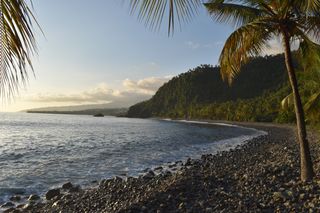
Anjouan island, off eastern coast of Africa, is mostly made of dark volcanic rocks, like these cobbles on the shoreline of one of the island's beaches. But researchers have now found a motherlode of "impossible" rocks on a ridgeline on the island. These out-of-place rocks are made of quartzite, a metamorphic rock that forms from sandstone, as in a riverbed or delta — not a volcano. [Read more about the Anjouan island rocks]
Out of place
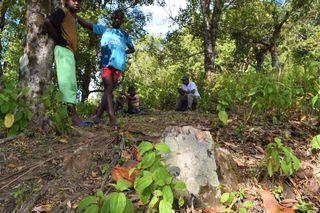
Local boys stand near a hunk of quartzite on Anjouan island. The rock doesn't look like anything that could have formed on volcanic Anjouan, said Cornelia Class, a geochemist at the Lamont-Doherty Earth Observatory at Columbia University. Geologists have been making scattered reports of quartzite on Anjouan for decades. In September 2018, Class led a field expedition to the island to find out how much quartzite there really is and where it's coming from.
Mountain of mystery
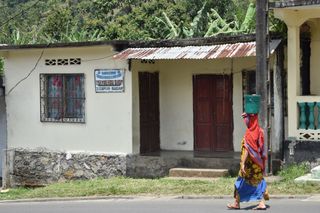
The motherlode of quartzite turned out to be near this mountain village, called Tsembehou, which is nestled among heavily forested volcanic slopes. A nearby ridge called Habakari N’gani is nearly half quartzite, Class and her colleagues found. This rock somehow ended up in the middle of the ocean basin between Africa and Madagascar, which shouldn't host any quartzite at all. Incredibly, as volcanic Anjouan formed, the quartzite lifted up along with its volcanic rocks some 13,120 feet (4,000 meters) from the seabed.
A use for quartzite
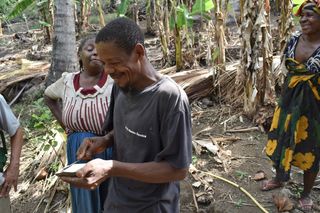
A local named Ali Saindou demonstrates how Anjouan residents use the cobbles of quartzite they find around the island. "We find these all the time when we're planting manioc," Saindou told Columbia's Kevin Krajick. "People use them to sharpen knives."
Because people use the quartzite, much of it has been cleared out of streambeds and rivers where it erodes, Class told Live Science. That made hunting for the source of the small boulders of quartzite even more challenging.
On the hunt
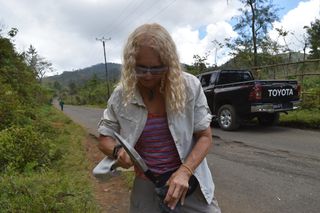
Cornelia Class of the Lamont-Doherty Earth Observatory uses a rock hammer to break apart a sample on the side of a road in Anjouan. Researchers searched for quartzite in outcrops by the sides of roads, in forest clearings and even in manmade rock walls, where scattered chunks of white sometimes peeked out from boulders of volcanic basalt.
Quartzite, found
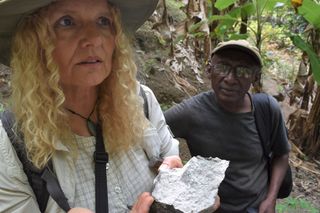
Cornelia Class holds a newly discovered piece of quartzite as Comorian government scientist Bourhane Abderemane looks on. The researchers had old geological maps guiding them toward previously discovered quartzite outcrops, but earlier reports were scattered and fragmentary.
Sign up for the Live Science daily newsletter now
Get the world’s most fascinating discoveries delivered straight to your inbox.
Heavy work
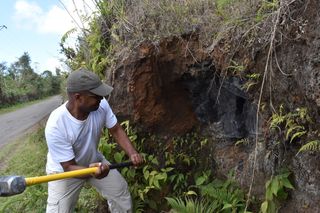
Comorian government geologist Hamidi Soulé prepares to crack into a roadside outcropping in search of quartzite. Anjouan island is a difficult place for a geologist, Class said, because most of the rocks on the island are covered with thick layers of soil and vegetation. Excavated roadbeds are one place where exposed rocks can be found.
Uphill march
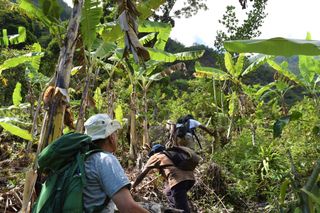
Researchers bushwhack uphill while on the hunt for the source of the quartzite boulders found dotting the hillsides on Anjouan. "It's basically like a big garden," Class said of the island. The researchers combed the area systematically, mapping occurrences of quartzite and asking local residents to point them to where they'd seen the white boulders.
Flying fruit bat
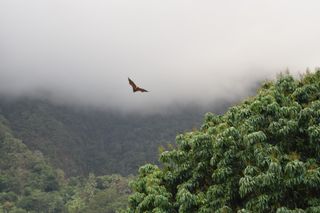
An enormous fruit bat wings its way over the mountains of Anjouan. Livingstone's fruit bats (Pteropus livingstonii) are found only on Anjouan and a nearby island, Mohéli. The bats can have wingspans of up to 4.5 feet (1.4 meters).
Clues in a cowfield
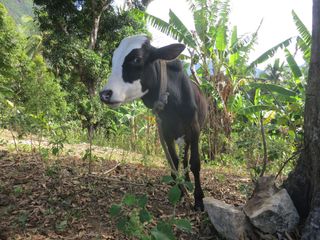
Hidden beneath the soil below this cow's feet is the motherlode: A large deposit of quartzite, making up nearly half of a mountain. The quartzite unit was much larger than expected, Class said. A couple small chunks of the rock that have weathered away from the main body of quartzite are propped next to the cow's front feet.
Ocean and land
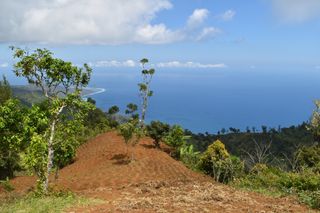
A view from Anjouan overlooking the sea. As the island was formed by a volcano, it should be entirely igneous, volcanic rock. The presence of the quartzite – a metamorphic rock formed from sandstone originally laid down in a river delta or on a beach — is mystifying. The rock likely came from the African continent, Class said, but it's not clear how it got into the middle of an ocean basin or how it became incorporated into Anjouan.

Stephanie Pappas is a contributing writer for Live Science, covering topics ranging from geoscience to archaeology to the human brain and behavior. She was previously a senior writer for Live Science but is now a freelancer based in Denver, Colorado, and regularly contributes to Scientific American and The Monitor, the monthly magazine of the American Psychological Association. Stephanie received a bachelor's degree in psychology from the University of South Carolina and a graduate certificate in science communication from the University of California, Santa Cruz.
